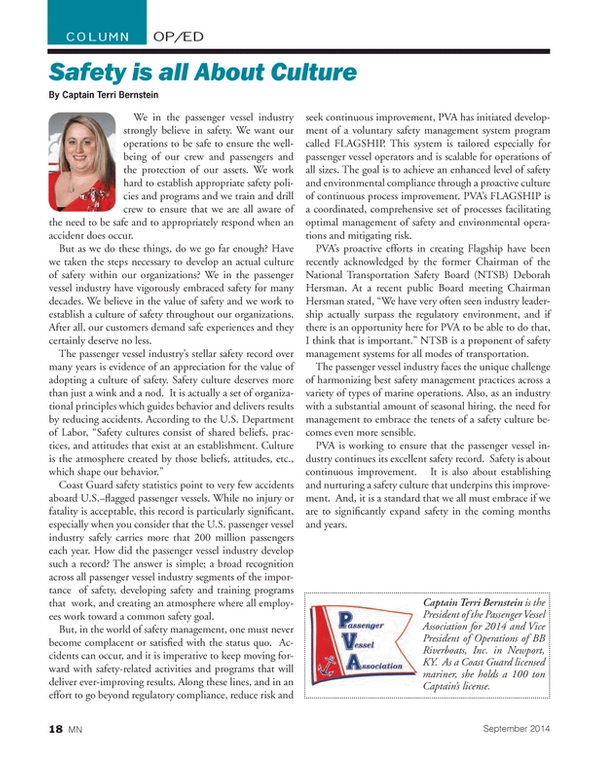
Safety: It's All About Culture
We in the passenger vessel industry strongly believe in safety. We want our operations to be safe to ensure the well-being of our crew and passengers and the protection of our assets. We work hard to establish appropriate safety policies and programs and we train and drill crew to ensure that we are all aware of the need to be safe and to appropriately respond when an accident does occur.
But as we do these things, do we go far enough? Have we taken the steps necessary to develop an actual culture of safety within our organizations? We in the passenger vessel industry have vigorously embraced safety for many decades. We believe in the value of safety and we work to establish a culture of safety throughout our organizations. After all, our customers demand safe experiences and they certainly deserve no less.
The passenger vessel industry’s stellar safety record over many years is evidence of an appreciation for the value of adopting a culture of safety. Safety culture deserves more than just a wink and a nod. It is actually a set of organizational principles which guides behavior and delivers results by reducing accidents. According to the U.S. Department of Labor, “Safety cultures consist of shared beliefs, practices, and attitudes that exist at an establishment. Culture is the atmosphere created by those beliefs, attitudes, etc., which shape our behavior.”
Coast Guard safety statistics point to very few accidents aboard U.S.–flagged passenger vessels. While no injury or fatality is acceptable, this record is particularly significant, especially when you consider that the U.S. passenger vessel industry safely carries more that 200 million passengers each year. How did the passenger vessel industry develop such a record? The answer is simple; a broad recognition across all passenger vessel industry segments of the importance of safety, developing safety and training programs that work, and creating an atmosphere where all employees work toward a common safety goal.
But, in the world of safety management, one must never become complacent or satisfied with the status quo. Accidents can occur, and it is imperative to keep moving forward with safety-related activities and programs that will deliver ever-improving results. Along these lines, and in an effort to go beyond regulatory compliance, reduce risk and seek continuous improvement, PVA has initiated development of a voluntary safety management system program called FLAGSHIP. This system is tailored especially for passenger vessel operators and is scalable for operations of all sizes. The goal is to achieve an enhanced level of safety and environmental compliance through a proactive culture of continuous process improvement. PVA’s FLAGSHIP is a coordinated, comprehensive set of processes facilitating optimal management of safety and environmental operations and mitigating risk.
PVA’s proactive efforts in creating Flagship have been recently acknowledged by the former Chairman of the National Transportation Safety Board (NTSB) Deborah Hersman. At a recent public Board meeting Chairman Hersman stated, “We have very often seen industry leadership actually surpass the regulatory environment, and if there is an opportunity here for PVA to be able to do that, I think that is important.” NTSB is a proponent of safety management systems for all modes of transportation.
The passenger vessel industry faces the unique challenge of harmonizing best safety management practices across a variety of types of marine operations. Also, as an industry with a substantial amount of seasonal hiring, the need for management to embrace the tenets of a safety culture becomes even more sensible.
PVA is working to ensure that the passenger vessel industry continues its excellent safety record. Safety is about continuous improvement. It is also about establishing and nurturing a safety culture that underpins this improvement. And, it is a standard that we all must embrace if we are to significantly expand safety in the coming months and years.
(As published in the September 2014 edition of Marine News - http://magazines.marinelink.com/Magazines/MaritimeNews)
Read Safety: It's All About Culture in Pdf, Flash or Html5 edition of September 2014 Marine News
Other stories from September 2014 issue
Content
- Insights: New York Canal Director Brian Stratton page: 12
- Safety: It's All About Culture page: 18
- In Support of Affordable Energy page: 20
- Business, Bankruptcy, Bad Debt – and You page: 22
- Skip, Skip, Skip to the Loot page: 26
- The No-Emissions Workboat (Really!) page: 28
- Specialty Workboat Missions Propelled by Innovative Engines page: 34
- Moose Boats’ Fire Rescue Catamaran page: 40
- Rope & Wires: At the Forefront of Technology page: 46
- HydraWrap: Not Just a Temporary Repair Anymore page: 48


